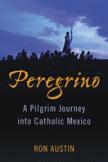Progress and Peril
One summer many years ago my mother took me, at age 11, to Mexico City from Los Angeles to meet my Mexican relatives for the first time. This was quite a shock: discovering an alternative world. Ever since then I have been trying to assimilate how such diverse universes can co-exist. So this is the book that I have always wanted to write myself, but this gringo Ron Austin, a senior Hollywood writer and producer of “Mission: Impossible,” “Matlock” and “Charlie’s Angels,” has beat me to it. As a bilingual, bicultural Mexican-American caught between worlds, I am deeply moved by Austin’s richly evocative vision of Mexico. He documents the encounter of Mexico’s people with their seemingly overpowering northern neighbor. Austin’s is the work of a lifetime and a labor of immense love.
For him it all started as a young man on a filming assignment to Mexico 50 years ago. One thing led to another over decades and the result is this brisk and engaging essay combining memoir, travel book, history and cultural analysis in a stimulating and pleasant read. In short, Austin fell in love with Mexico and with the people’s everyday Catholicism. He also fell in love with the God revealed in Jesus Christ; and even more, he clearly and unabashedly chose to follow Christ in the Catholic community of faith.
There is something remarkable about the robustness of Austin’s enthusiasm for his Catholic faith, including the institutional church in this day and age. His apologetic is at once intelligent, nonsectarian, dialogical, respectful and even contagious. Coming from a man with such excellent worldly credentials, who flourishes in Hollywood’s hyper-secularity, the book is fascinating and unexpected. Perhaps it exemplifies the coming shape of religion in a post-secular age.
Austin weaves several threads into his narrative. The first is the lived reality of ordinary Mexicans. The author strives to capture the particularity of the people through a vivid historical lens. He does a credible job of synthesizing key moments of the past 500 years since the Spanish conquest, leaning on respected Mexican thinkers like the Nobel Prize-winning literary giant Octavio Paz.
Mexico’s engagement with Catholicism is the book’s second thread. In this Austin demonstrates that he is a student of cultural and theological anthropology. For him symbol, ritual and myth in the form of stories of the saints play a vital role in getting underneath the skin of a people. The book is full of examples taken from ethnographic observations. To this he adds plenty of theological and philosophical reflection inspired by heavyweights the likes of de Lubac, Congar, von Balthasar, Pelikan, Girard and Pope Benedict XVI.
The essay’s third thread is the relationship between Mexican and American cultures. What is the impact of one on the other? Where is the en-counter of two wildly antithetical nations actually heading, especially in relation to U.S. Catholicism? Austin seeks to answer these questions in terms of the role played by religion in the experience of most Mexicans.
This is a timely question, especially for the Catholic Church in the United States, in light of the contention by the researchers Putnam and Campbell in their recent publication, American Grace. There they leave no room for doubt that Hispanic Catholics (65 percent of them of Mexican origin) are the leading indicators of the U.S. Catholic Church’s future. In this, Austin’s focus coincides beautifully with the late Cardinal Avery Dulles’s observation that the coming of Catholic immigrants from Latin America offers a golden opportunity for Catholicism to affect U.S. culture more substantially than ever before.
Perhaps the heart of Austin’s message is found in a wide-ranging chapter titled “Progress and Peril: Mexico and the Crisis of Modernity.” He shows how neither the pervasive U.S. emphasis on the autonomous self nor the dominant secular ideologies of Europe have succeeded in winning the hearts of mainstream Mexicans. Will modernity’s “acids” ultimately uproot their distinctive worldview with its “love of community, work, family ties, and tradition?” Of particular interest in this connection is Austin’s reference to the “thwarted mysticism” of middle-class Western spirituality, which tends to lead its practitioners to a life of isolation unhinged from community and tradition.
There is a gentle polemic underneath some of Austin’s assessments of recent church history showing sympathy for Cardinal Joseph Ratzinger’s critique directed toward liberation theology in two Vatican documents of the 1980s. Austin suggests that the underlying spirit of a theological vision stressing social change can degenerate into mere activism, a replay of a persistent Pelagianism. While not denying faith’s link with justice, what Austin finds so appealing in Hispanic Catholicism is something else: its straightforward supernaturalism and recognition of sacrifice as linked to agape and modeled on the paschal mystery. For Christians suffering can be redemptive, and the Mexicans so admired by Austin know it.
This is not a scholarly work. Rather, it is a sui generis exercise that synthesizes years of musings from a deeply personal faith perspective. There are inaccuracies: for example, when the author states that Morelos, a leader of the independence movement from Spain, became a priest “at the then-late age of twenty-five.” At that time 24 was the youngest age at which one could be ordained a priest; so this assertion makes no sense. At times the author also seems opinionated, dropping criticisms here and there but giving little explanation. Yet ultimately the book is a rewarding read for anyone interested in grasping what is at stake today in the drama of religious and spiritual transformations taking place in the bosom of U.S. Catholicism.
This article also appeared in print, under the headline “Progress and Peril,” in the January 24, 2011, issue.








